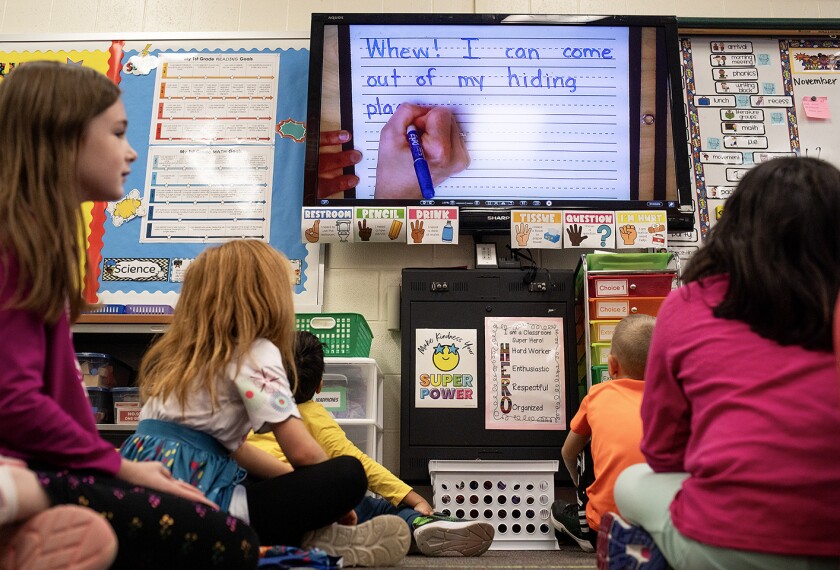Children and adults alike get bombarded with questionable information every day, whether it’s fake TikTok videos on the war in Ukraine, targeted ads on Facebook, or disinformation on climate change on TV.
The challenge, for schools, is to prepare students to enter adulthood prepared to detect bias and recognize when they are being manipulated.
But, apparently, schools are not teaching those skills. That’s according to a new survey by Media Literacy Now, a nonprofit group that advocates for teaching media literacy skills in schools. A recent survey it conducted found that nearly half of adults ages 19 to 81 did not learn media literacy skills in high school. The average age of respondents was 41.
When asked if they were taught how to analyze science news stories for bias and credibility, 46 percent of respondents said no. Forty-two percent said they had been taught those skills, while 11 percent were unsure, according to the survey of 541 adults conducted between May and June 2022. Sixty-five percent had completed a bachelor’s degree or higher.
Thirty-eight percent of the adults surveyed said they had learned how to analyze media messaging while in high school, such as reflecting on how advertising or TV programs affect people’s thoughts, beliefs, feelings, or actions. The findings are part of a broader survey on science literacy among adults administered by Media Literacy Now in partnership with the Reboot Foundation.
Interestingly, the survey also found the respondents who said they had participated in media literacy education in high school were among the least likely to believe in conspiracy theories.
It’s a whole community effort that’s needed and we can’t rely on individual teachers. They have a lot on their plates.
Media literacy is more expansive than simply knowing how to fact-check the accuracy of claims, said Erin McNeill, the founder and president of Media Literacy Now. To be media literate requires understanding how the media system—which includes TV and digital or print news, social media, advertising, podcasts, video games, and anything else that conveys a message—works to shape us as individuals and as a society.
“And finally, to be media literate, just like you learn to read and write, you also understand how to create messages with the many tools now available to us,” McNeill says.
Students are online more than ever and misinformation and disinformation is everywhere
There is a growing push among some sectors in the K-12 education field and among state policymakers to teach media literacy skills in schools as the media system becomes more complex and students spend more time online. That means more time to come into contact with misinformation or advertising. Those are not new challenges, but they have been supercharged by big data and algorithms, which can heavily influence the minds of people who are not critical thinkers.
Average screen use for kids ages 8 to 18 rose sharply—by 17 percent—from 2019 to 2021, according to a separate survey released earlier this year by Common Sense Media. Teens spent eight hours and 39 minutes on screens per day in 2021, compared with seven hours and 22 minutes in 2019. Tweens, ages 8 to 12, spent five hours and 33 minutes on screens in 2021, compared with four hours and 44 minutes in 2019. Four years earlier, teens were spending six hours and 40 minutes on entertainment screen use, while tweens were clocking four hours and 36 minutes per day.
Boys are on screens more than girls, the Common Sense Media survey found. Black and Hispanic children use them more than white children, and children from lower- and middle-income households use screens for entertainment more than children from higher income households.
Kids spent the most of their media time watching TV and videos, followed by gaming, browsing websites, social media, content creation, video chatting, and online reading.
Over the past two years, time reading on screens remained flat while time spent watching online videos, using social media, and browsing websites shot up.
Teens struggle to distinguish ‘fake news’ from real news
Despite being “digital natives,” teenagers can struggle distinguishing “fake news” from real news, researchers at Stanford University have found. In one study, 3,450 students in grades 9-12 participated in six exercises testing their abilities to spot fake claims on voter fraud, distinguish a news article from an advertisement on a news website, spot that a nonprofit climate change group had actually been set up by a fossil fuel group, and scrutinize a tweet from an advocacy group.
On each task, at least two-thirds of students received the lowest ranking out of three levels.
In the recent Media Literacy Now survey, a significant majority of the people—84 percent—said they are in favor of state policies that require schools to teach media literacy skills. Twelve percent were against the idea.
Fifteen states address media literacy in some way in education law, according to Media Literacy Now. States do this either by requiring that schools teach the subject, allowing media literacy courses to count toward certain requirements, making resources available to teachers, or developing a media literacy committee. Policymakers can also promote media literacy through education standards.
But, for the most part, it falls on individual teachers to teach media literacy, said McNeill, a situation that is far from ideal.
“It’s really important that teachers are supported across all levels,” she said. “That states are incorporating this into guidelines and standards and providing resources to schools. It’s a whole community effort that’s needed and we can’t rely on individual teachers. They have a lot on their plates.”








